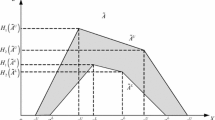Abstract
On the basis of two-dimension uncertain linguistic variables, in this paper, we further presented a trapezoidal fuzzy two-dimension linguistic variable in which the first dimensional linguistic uncertain information is extended to trapezoidal fuzzy number. First, the definition, operational laws, characteristics, expectation, comparative method and distance of trapezoidal fuzzy two-dimension linguistic information are proposed. Then, the trapezoidal fuzzy two-dimension linguistic power generalized aggregation operator and the trapezoidal fuzzy two-dimension linguistic power generalized weighted aggregation (TF2DLPGWA) operator are developed, and some properties and special cases of these operators are analyzed. Furthermore, based on the TF2DLPGWA operator and the comparative formula of the trapezoidal fuzzy two-dimension linguistic variables, an approach to group decision making with trapezoidal fuzzy two-dimension linguistic variables is established. Finally, an illustrative example is given to verify the developed approach and to demonstrate its practicality and effectiveness.
Similar content being viewed by others
References
Atanassov KT (1986) Intuitionistic fuzzy sets. Fuzzy Sets Syst 20:87–96
Chu TC (2002) A fuzzy number interval arithmetic based fuzzy MCDM algorithm. Int J Fuzzy Syst 4:867–872
Delgado M, Verdegay JL, Vila MA (1993) On aggregation operations of linguistic labels. Int J Intell Syst 8:351–370
Herrera F, Herrera-Viedma E (2000) Linguistic decision analysis: steps for solving decision problems under linguistic information. Fuzzy Sets Syst 115:67–82
Herrera F, Herrera-Viedma E, Verdegay JL (1996) A model of consensus in group decision making under linguistic assessments. Fuzzy Sets Syst 79:73–87
Li RJ (2002) Theory and application on the fuzzy multiple attribute decision making. Science Press, Beijing
Li DF (2011) The GOWA operator based approach to multi-attribute decision making using intuitionistic fuzzy sets. Math Comput Model 53:1182–1196
Liu PD (2009) A novel method for hybrid multiple attribute decision making. Knowl-Based Syst 22:388–391
Liu PD (2013a) Some generalized dependent aggregation operators with intuitionistic linguistic numbers and their application to group decision making. J Comput Syst Sci 79(1):131–143
Liu PD (2013b) The multi-attribute group decision making method based on the interval grey linguistic variables weighted aggregation operator. J Intell Fuzzy Syst 24(2):405–414
Liu PD (2014) Some Hamacher aggregation operators based on the interval-valued intuitionistic fuzzy numbers and their application to Group Decision Making. IEEE Trans Fuzzy Syst 22(1):83–97
Liu PD, Jin F (2012) Methods for aggregating intuitionistic uncertain linguistic variables and their application to group decision making. Inf Sci 205:58–71
Liu PD, Liu Y (2014) An approach to multiple attribute group decision making based on intuitionistic trapezoidal fuzzy power generalized aggregation operator. Int J Comput Intell Syst 7(2):291–304
Liu PD, Liu ZM, Zhang X (2014) Some intuitionistic uncertain linguistic Heronian mean operators and their application to group decision making. Appl Math Comput 230:570–586
Liu PD, Wang YM (2014) Multiple attribute group decision making methods based on intuitionistic linguistic power generalized aggregation operators. Appl Soft Comput 17:90–104
Liu PD, Yu XC (2014) 2-Dimension uncertain linguistic power generalized weighted aggregation operator and its application for multiple attribute group decision making. Knowl-Based Syst 57:69–80
Liu PD, Zhang X (2012) An approach to group decision making based on 2-dimension uncertain linguistic assessment information. Technol Econ Dev Econ 18:424–437
Su ZB (2006) Study on consistency issues and sorting methods based on three kinds of judgment matrix in FAHP. Xi’an University of Technology, Xian
Wang JQ (2004) Programming method of fuzzy group multiple criteria decision making with incomplete information. Syst Eng Electron 26:1604–1608
Wang JQ (2008) Overview on fuzzy multi-criteria decision making approach. Control Decis 23:601–606
Wei GW (2010) Some induced geometric aggregation operators with intuitionistic fuzzy information and their application to group decision making. Appl Soft Comput 10:423–431
Xu ZS (2002) Study on method for triangular fuzzy number-based multi-attribute decision making with preference information on alternatives. Syst Eng Electron 24:9–12
Xu ZS (2008) Linguistic aggregation operators: an overview. In: Bustince H, Herrera F, Montero J (eds) Fuzzy sets and extensions: representation, aggregation and models. Springer, Berlin, Heidelberg, pp 163–181
Xu ZS, Da QL (2003) Possibility degree method for ranking interval numbers and its application. J Syst Eng 18:67–70
Xu ZS, Yager RR (2006) Some geometric aggregation operators based on intuitionistic fuzzy sets. Int J Gen Syst 35:417–433
Yager RR (2001) The power average operator. IEEE Trans Syst Man Cybern- Part A: Syst Hum 31:724–731
Yager RR (2004) Generalized OWA aggregation operators. Fuzzy Optim Decis Mak 3:93–107
Yu XH, Xu ZS, Liu SS, Chen Q (2012) Multi-criteria decision making with 2-dimension linguistic aggregation techniques. Int J Intell Syst 27:539–562
Zadeh LA (1965) Fuzzy sets. Inf Control 8:338–356
Zadeh LA (1975a) The concept of a linguistic variable and its applications to approximate reasoning-I. Inf Sci 8:199–249
Zadeh LA (1975b) The concept of a linguistic variable and its applications to approximate reasoning-II. Inf Sci 8:301–357
Zadeh LA (1975c) The concept of a linguistic variable and its applications to approximate reasoning-III. Inf Sci 9:43–80
Zhang C, Zhou GZ, Zhu WD (2012) Research on peer review system for the National Science Foundation based on two-dimensional semantics evidence reasoning. China Soft Sci 2:176–182
Zhou LG, Chen HY, Liu JP (2012) Generalized power aggregation operators and their applications in group decision making. Comput Ind Eng 62:989–999
Zhu WD, Zhou GZ, Yang SL (2009) An approach to group decision making based on 2-dimension linguistic assessment information. Syst Eng 27:113–118
Acknowledgments
This paper is supported by the National Natural Science Foundation of China (No. 71471172 and No. 71271124), the Humanities and Social Sciences Research Project of Ministry of Education of China (No. 13YJC630104), Shandong Provincial Social Science Planning Project (No.13BGLJ10), Graduate education innovation projects in Shandong Province (SDYY12065) and The National Soft Science Project (2014GXQ4D192). The author also would like to express appreciation to the anonymous reviewers and Editors for their very helpful comments that improved the paper.
Author information
Authors and Affiliations
Corresponding author
Additional information
Communicated by V. Loia.
Rights and permissions
About this article
Cite this article
Li, Y., Wang, Y. & Liu, P. Multiple attribute group decision-making methods based on trapezoidal fuzzy two-dimension linguistic power generalized aggregation operators. Soft Comput 20, 2689–2704 (2016). https://doi.org/10.1007/s00500-015-1668-7
Published:
Issue Date:
DOI: https://doi.org/10.1007/s00500-015-1668-7



